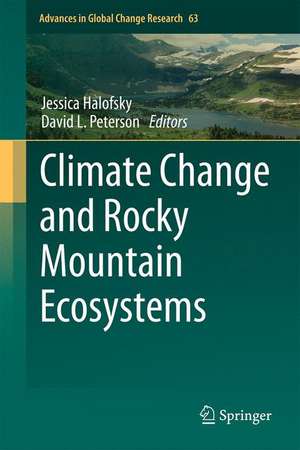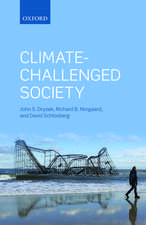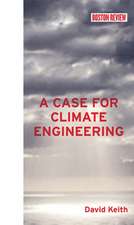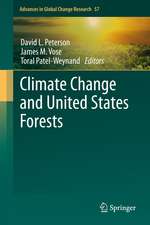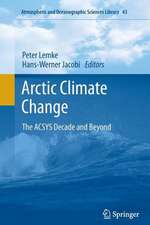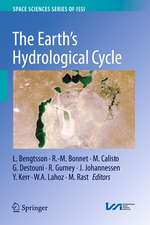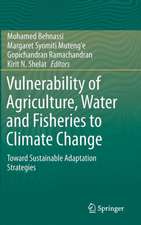Climate Change and Rocky Mountain Ecosystems: Advances in Global Change Research, cartea 63
Editat de Jessica Halofsky, David L. Petersonen Limba Engleză Hardback – 7 aug 2017
This book is the result of a team of approximately 100 scientists and resource managers who worked together for two years to understand the effects of climatic variability and change on water resources, fisheries, forest vegetation, non-forest vegetation, wildlife, recreation, cultural resources and ecosystem services. Adaptation options, both strategic and tactical, were developed for each resource area. This information is now being applied in the northern rocky Mountains to ensure long-term sustainability in resource conditions.
The volume chapters provide a technical assessment of the effects of climatic variability and change on natural and cultural resources, based on best available science, including new analyses obtained through modeling and synthesis of existing data. Each chapter also contains a summary of adaptation strategies (general) and tactics (on-the-ground actions) that have been developed by science-management teams.
| Toate formatele și edițiile | Preț | Express |
|---|---|---|
| Paperback (1) | 548.84 lei 38-44 zile | |
| Springer International Publishing – 12 iun 2018 | 548.84 lei 38-44 zile | |
| Hardback (1) | 895.45 lei 3-5 săpt. | |
| Springer International Publishing – 7 aug 2017 | 895.45 lei 3-5 săpt. |
Din seria Advances in Global Change Research
- 15%
 Preț: 636.12 lei
Preț: 636.12 lei -
 Preț: 439.83 lei
Preț: 439.83 lei - 15%
 Preț: 648.24 lei
Preț: 648.24 lei - 18%
 Preț: 1036.54 lei
Preț: 1036.54 lei - 18%
 Preț: 894.16 lei
Preț: 894.16 lei - 18%
 Preț: 963.60 lei
Preț: 963.60 lei - 18%
 Preț: 1239.49 lei
Preț: 1239.49 lei - 15%
 Preț: 649.71 lei
Preț: 649.71 lei - 18%
 Preț: 1243.78 lei
Preț: 1243.78 lei - 18%
 Preț: 1114.02 lei
Preț: 1114.02 lei - 15%
 Preț: 648.89 lei
Preț: 648.89 lei - 18%
 Preț: 960.78 lei
Preț: 960.78 lei - 15%
 Preț: 643.99 lei
Preț: 643.99 lei - 18%
 Preț: 1834.44 lei
Preț: 1834.44 lei - 15%
 Preț: 649.06 lei
Preț: 649.06 lei - 18%
 Preț: 955.70 lei
Preț: 955.70 lei - 18%
 Preț: 956.03 lei
Preț: 956.03 lei - 18%
 Preț: 1232.26 lei
Preț: 1232.26 lei - 18%
 Preț: 955.88 lei
Preț: 955.88 lei - 18%
 Preț: 959.19 lei
Preț: 959.19 lei - 18%
 Preț: 944.82 lei
Preț: 944.82 lei - 18%
 Preț: 1105.19 lei
Preț: 1105.19 lei - 15%
 Preț: 644.49 lei
Preț: 644.49 lei - 15%
 Preț: 643.99 lei
Preț: 643.99 lei - 18%
 Preț: 1841.54 lei
Preț: 1841.54 lei - 18%
 Preț: 1225.94 lei
Preț: 1225.94 lei - 18%
 Preț: 954.62 lei
Preț: 954.62 lei - 5%
 Preț: 1414.80 lei
Preț: 1414.80 lei
Preț: 895.45 lei
Preț vechi: 1092.01 lei
-18% Nou
Puncte Express: 1343
Preț estimativ în valută:
171.36€ • 186.08$ • 143.95£
171.36€ • 186.08$ • 143.95£
Carte disponibilă
Livrare economică 01-15 aprilie
Preluare comenzi: 021 569.72.76
Specificații
ISBN-13: 9783319569277
ISBN-10: 3319569279
Pagini: 234
Ilustrații: XVII, 236 p. 42 illus., 37 illus. in color.
Dimensiuni: 155 x 235 mm
Greutate: 0.57 kg
Ediția:1st ed. 2018
Editura: Springer International Publishing
Colecția Springer
Seria Advances in Global Change Research
Locul publicării:Cham, Switzerland
ISBN-10: 3319569279
Pagini: 234
Ilustrații: XVII, 236 p. 42 illus., 37 illus. in color.
Dimensiuni: 155 x 235 mm
Greutate: 0.57 kg
Ediția:1st ed. 2018
Editura: Springer International Publishing
Colecția Springer
Seria Advances in Global Change Research
Locul publicării:Cham, Switzerland
Cuprins
Chapter 1. Introduction and Biogeography (Jessica Halofsky, David Peterson, and Karen Dante-Wood).- Chapter 2. Climatology (Linda Joyce and Marian Talbert).- Chapter 3. Water Resources (Chales Luce).- Chapter 4. Fisheries (Michael Young and Daniel Isaak). - Chapter 5. Forest Vegetation (Robert Keane).- Chapter 6.- Non-Forest Vegetation (Matthew Reeves).- Chapter 7. Ecological Disturbance (Rachel Loehman).- Chapter 8. - Wildlife (Kevin McKelvey and Polly Buotte).- Chapter 9. Recreation (Michael Hand and Megan Lawson).- Chapter 10.- Ecosystem Services (Travis Warziniack).- Chapter 11. Cultural Resources (Carl Davis).- Chapter 12. Applications in Resource Management and Planning (Karen Dante-Wood and Linh Hoang).
Notă biografică
Dr. Jessica Halofsky is a Research Scientist in the University of Washington, School of Environmental and Forest Sciences. She has been involved in climate change research since 2008, and is a national leader in climate change adaptation, especially the application of climate change science in natural resource management. The author of many journal articles and book chapters on climate change and fire ecology, this will be her first book.
Dr. David Peterson is a Senior Research Biologist with the U.S. Forest Service Pacific Northwest Research Station. He has been involved in climate change research for 25 years and is a national leader in climate change assessment and adaptation. The author of 220 scientific articles, this will be his fourth book, including Climate Change and United States Forests (a Choice Award winner published by Springer in 2014).
Dr. David Peterson is a Senior Research Biologist with the U.S. Forest Service Pacific Northwest Research Station. He has been involved in climate change research for 25 years and is a national leader in climate change assessment and adaptation. The author of 220 scientific articles, this will be his fourth book, including Climate Change and United States Forests (a Choice Award winner published by Springer in 2014).
Textul de pe ultima copertă
This book is the result of a team of approximately 100 scientists and resource managers who worked together for two years to understand the effects of climatic variability and change on water resources, fisheries, forest vegetation, non-forest vegetation, wildlife, recreation, cultural resources and ecosystem services. Adaptation options, both strategic and tactical, were developed for each resource area. This information is now being applied in the northern rocky Mountains to ensure long-term sustainability in resource conditions.
The volume chapters provide a technical assessment of the effects of climatic variability and change on natural and cultural resources, based on best available science, including new analyses obtained through modeling and synthesis of existing data. Each chapter also contains a summary of adaptation strategies (general) and tactics (on-the-ground actions) that have been developed by science-management teams.
Caracteristici
Details the largest climate change vulnerability assessment in North America Provides unique insight into the potential effects of climate change in Montana, North Dakota, northern Idaho and northwestern Wyoming Each chapter is illustrated with colour figures, maps and tables
